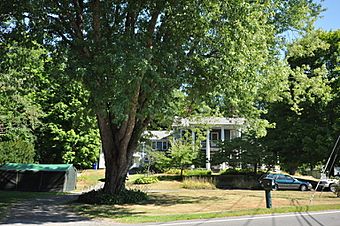Whitfield Cowles House facts for kids
Quick facts for kids |
|
|
Whitfield Cowles House
|
|
 |
|
| Location | 118 Spoonville Rd., East Granby, Connecticut |
|---|---|
| Area | 3.75 acres (1.52 ha) |
| Built | 1785 |
| Architectural style | Colonial, Colonial Revival |
| NRHP reference No. | 13000528 |
| Added to NRHP | April 8, 2014 |
The Whitfield Cowles House is a special old home located at 118 Spoonville Road in East Granby, Connecticut. It was built around 1785. This house was once home to Whitfield Cowles, a clever person who helped invent a new way to make silver-plated items. Even today, the house is still owned by his family! It was added to the National Register of Historic Places in 2014 because of its important history.
What Does the Whitfield Cowles House Look Like?
The Whitfield Cowles House is in a quiet, mostly rural area of East Granby. It sits on the north side of Spoonville Road. The house faces south on what used to be an old colonial road. It is part of a property that is about 3.75 acres big, mostly covered with trees.
The house is a two-and-a-half-story building made of wood. It has a roof that slopes down on two sides, with chimneys at each end. The outside is covered with wooden boards called clapboards. The most striking part of the house is its large front porch, called a Colonial Revival portico. This porch covers the middle three sections of the house.
It has four tall, fluted (grooved) columns that support a narrow decorative band and a fancy edge. There's also a balcony under the porch, right above the main front door. The front entrance itself, with windows on either side, was also updated in the early 1900s. Inside, the house has a central hallway with a straight staircase. The inside design mixes older styles from the late 1700s with newer Colonial Revival touches.
Who Was Whitfield Cowles?
The Whitfield Cowles House was built around 1785, probably by Joseph Griswold Jr. In 1802, he sold the house and about 75 acres of land to Reverend Whitfield Cowles. Whitfield Cowles was a minister, but he didn't earn enough money from his church. So, he started looking for other ways to make a living.
In 1808, he left his job as a minister because of some disagreements. After that, he focused completely on his businesses. He worked with partners to create a textile (fabric) business. He also made tools and equipment for carding, which is a process used in making textiles.
Innovating with Silver
One of Whitfield Cowles' most important projects was starting a wire factory near his home. Here, he began to experiment with a new process called electroplating silver. This is a way to put a thin layer of silver onto other metals. After he passed away, his son William continued his father's work.
William Cowles teamed up with silversmiths in Hartford, Connecticut. They started making silver-plated spoons and then expanded to many other household silver items. By the mid-1840s, Cowles' products were being sent as far away as South Carolina!
Even though the business faced challenges and eventually closed, the ideas and methods developed by Whitfield and William Cowles were very important. Other people who worked with them or were inspired by them went on to create even more successful silver-plating companies. This helped Connecticut become a major center for making silver-plated goods by the late 1800s.



